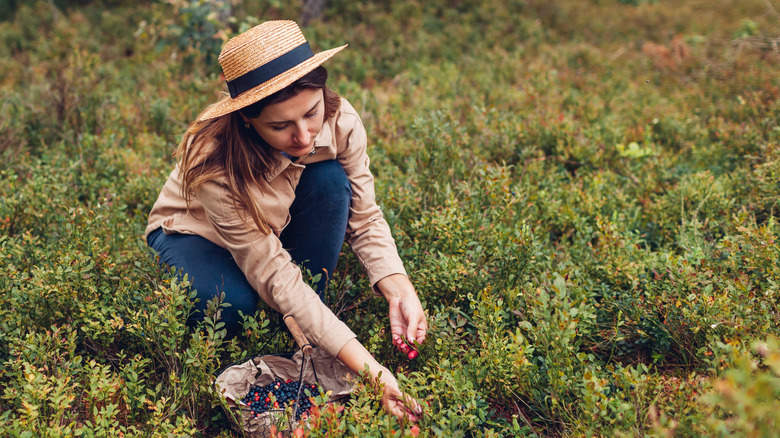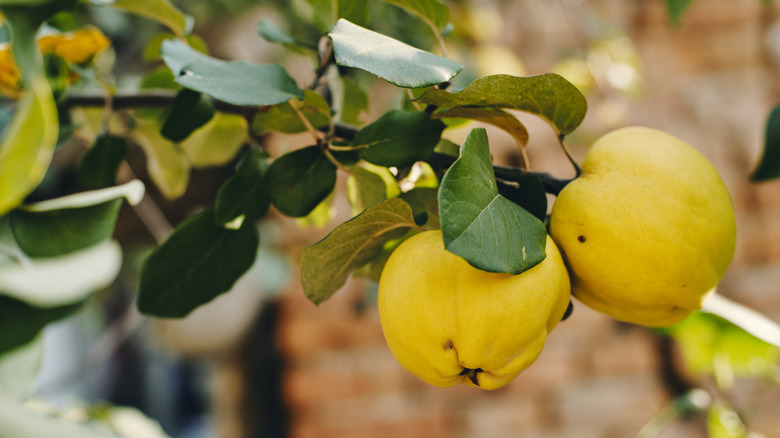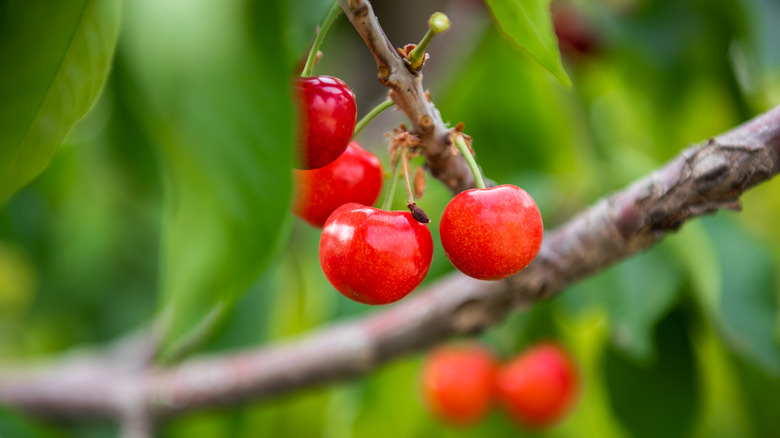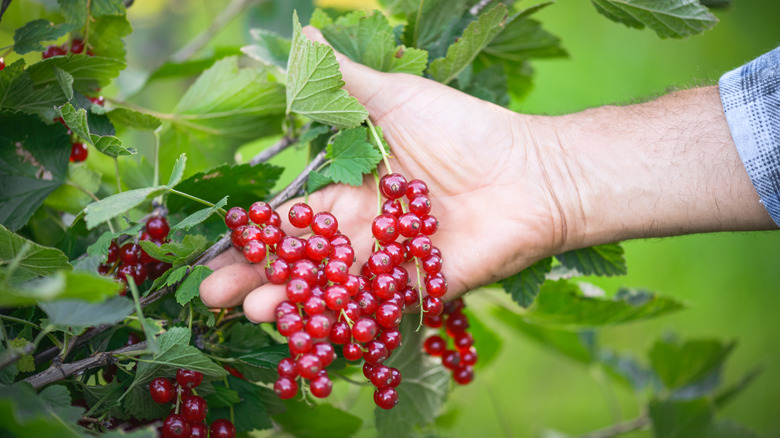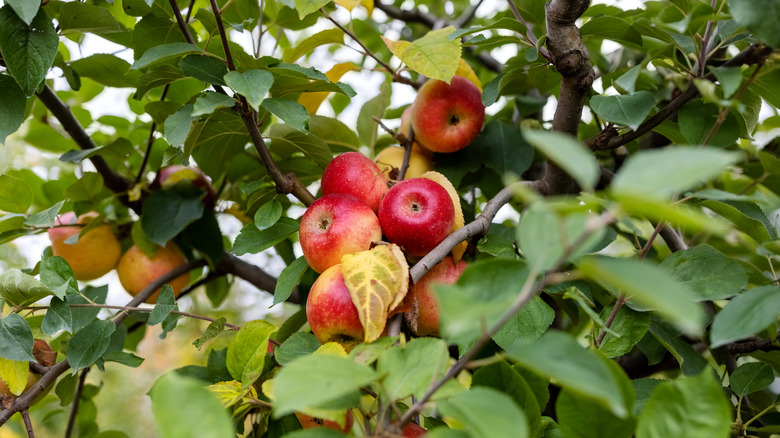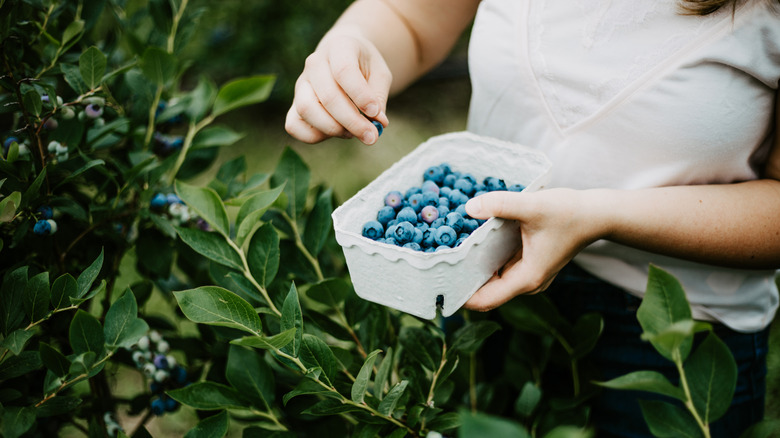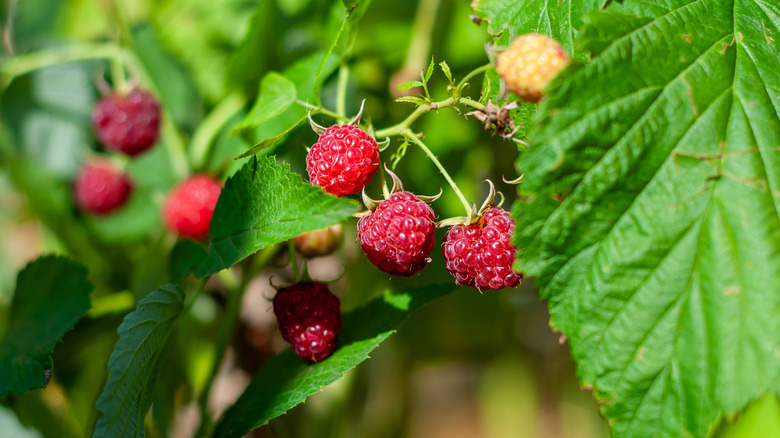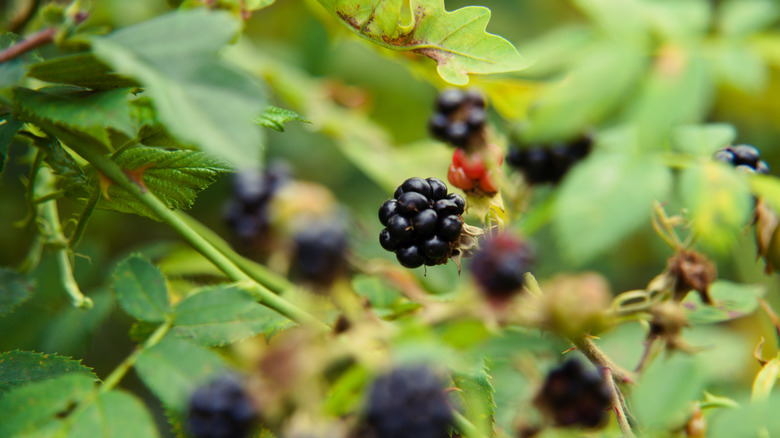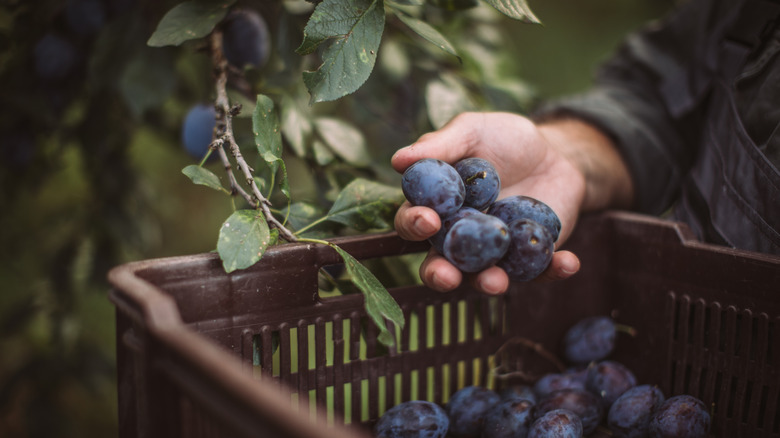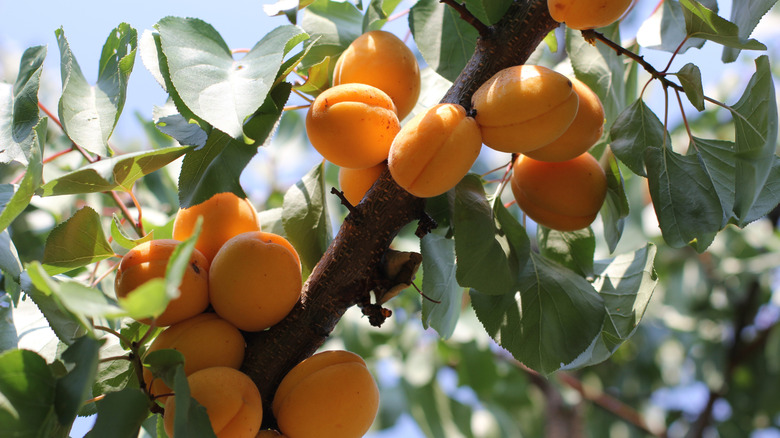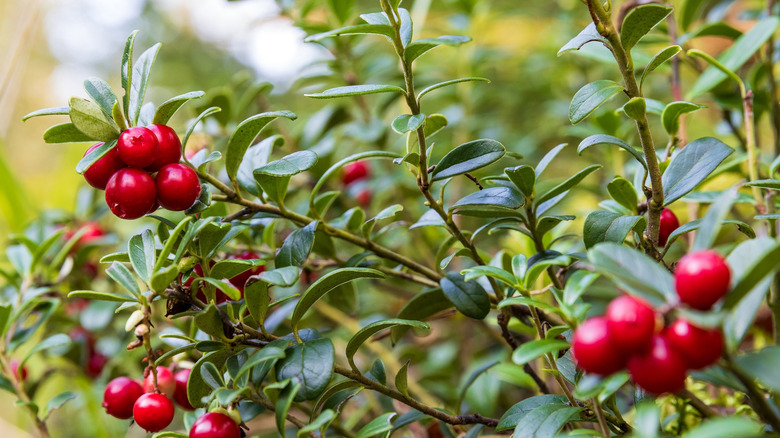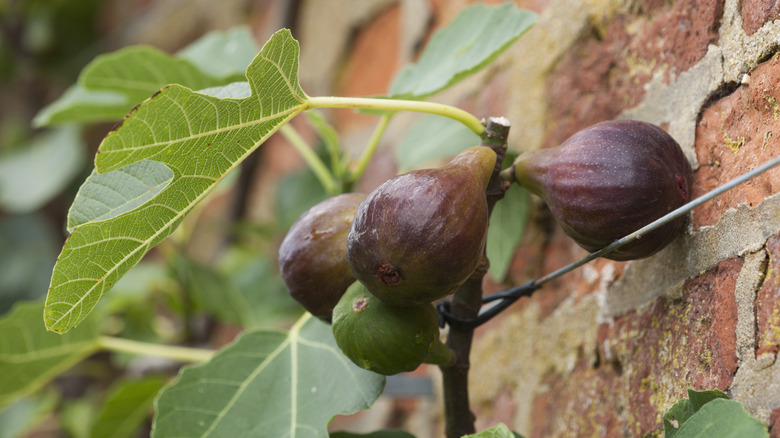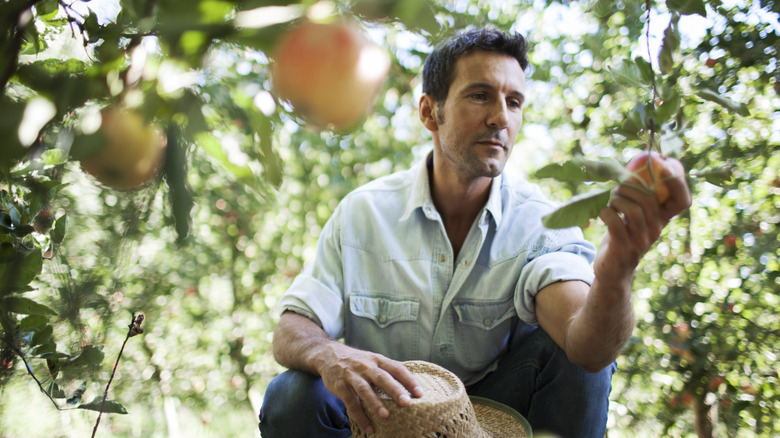Wild & Edible: A Traveler's Guide To Seasonal Fruit Foraging Across Europe
Europe draws travelers from around the world for many reasons: The cathedrals that have been standing for centuries, the Alps that offer spectacular hiking, and the myriad museums, to name a few. As you scroll through pictures of your friends' Euro summers, there's one theme that will keep coming up time and again: Food. Europe is known for its diversity of gelatos, cakes, pastas, pizzas, breads, and soups. Particularly when you visit during the summer, you can add fresh, forageable fruits to that list.
Drawing upon my experiences living and traveling in Europe, I have curated this guide to introduce you to a heaping handful of fruits that can be foraged there. Each country has a unique set of regulations that you should follow when foraging for produce, but thankfully, picking fruit on public lands in Europe is often permissible (I recommend using the Falling Fruit app to locate trees and bushes). The harvesting seasons noted in this article are variable; they can be several weeks earlier for warmer climates, including much of southern Europe. The European Food Information Council (EUFIC) has published an excellent tool for determining what produce is in season for each country.
I will also suggest a few recipes for each fruit in case you have access to a kitchen or you want to know what is worth trying at a local restaurant. Finally, while foraging can be a filling and fulfilling experience, you should always exercise caution to ensure that you do not accidentally pick poisonous berries!
Quince
No, this fruit is not pronounced in the same way as you would pronounce the Spanish translation for the number five. Instead, the Cambridge dictionary states that it sounds like "kwɪns." Though relatively unknown in the United States, this fruit is famous across Europe. Grown on shrubs or trees, the common quince transitions from green to yellow when ripe and matures into a round or pear-like shape roughly the size of a palm. Quince is primarily grown in areas that regularly experience a proper winter season, such as Ukraine and Serbia. Flowering quince is a related species, but it is usually grown for its flowers rather than its fruits.
Quince is one of the few fruits on this list that can be foraged in the fall; for instance, quince season generally runs from September through November in the United Kingdom. Look for this fruit along fencerows and south or southwest facing walls, especially in colder climates.
Once you have a few ripe quince fruits in your hands, it's best to cook with them rather than eat them raw. Indeed, these fruits are acidic and hard in their unprocessed state. Luckily, many cuisines have developed uses for quince, often in conjunction with cheese. I have fond memories of eating a quince jam and cheese sandwich in Oxford, and you might also find quince jam served alongside an array of cheeses in popular fall foodie destination Porto, Portugal. In Spain, quince paste is known as "dulce de membrillo," and is enjoyed alongside Manchego cheese or as a dessert.
Cherries
It's time to expand your palette beyond Rainier and Bing cherries. A large number of cherry varieties are cultivated in Europe, including sweet types like Lapins and Sweetheart and sour options like Marasca and Amarena. If this last variety sounds familiar, it's probably because you have heard of the mouthwatering Amarena gelato, an Italian specialty that combines sweet, often vanilla-flavored gelato with ruby red ribbons of Amarena cherry preserves. This iconic dish should be enough to convince you that even if sour cherries are all you can forage, they can still be transformed into something wonderful in the kitchen.
In Europe, the season for harvesting cherries ranges from May to July, with peak periods largely depending on the latitude. If you are foraging for wild cherries, note that they tend to grow prolifically in and around forests. Ripe cherries will be firm and plump. If you do not know the variety of the cherries you are picking, do not judge their ripeness by color alone; once mature, cherries can range from sunshine yellow to blood red in color. You should not have to tug too hard to detach a ripe cherry from its stem.
In addition to the Amarena gelato previously mentioned, it's well worth trying cherry frangipane and cherry clafoutis in France. The former is a tart enriched with the flavor of almonds, while the latter is a creamy custard. Meanwhile, Ukraine's cherry vareniki make excellent use of sour cherries.
Red currants
Red currants are one of those fruits that many Americans have never heard of, but Europeans have developed countless recipes to enhance its flavors. The season for red currants runs from early July until the middle of August in the United Kingdom and northern Europe. While foraging, you may also stumble across black currants, which ripen a few weeks later. Red currants, however, usually possess a sweeter, gentler flavor compared to black currants and often garner more culinary favor as a result. These small, red fruits seem to glow like Christmas lights when ripe, and you should take care to avoid confusing them with gooseberries (which are striped) and guelder rose berries (which can be slightly toxic when uncooked). Red currants can grow deep in the woods, often in wet places.
Red currants can be tart, in which case you may want to combine them with sugar, honey, or other berries in the kitchen. I love that European cakes are often less sweet than their American counterparts, and this fact is beautifully demonstrated in the red currant cakes often baked in Germany and Austria. You'll also find that a jelly can be made of red currants and served alongside meats such as lamb.
Apples
You have probably had a fair share of apples in your life, but if you visit northern Europe during the late summer or fall, odds are high that you will enjoy quite a few more. The apples in Europe are often different than the ones we have in the United States; while you still might encounter varieties like Gala and Golden Delicious, you may also be exposed to Jonagold, Szampion, and Gloster apples.
Some of these apples are sweet, while others are sour, and wild apples can be especially mouth-puckering. For that reason, foraging for apples can be a bit of a hit-or-miss, so I suggest looking for trees intentionally planted on public lands, such as those in parks, rather than those randomly growing alongside hiking trails. The former may carry sweeter fruits than the latter. An apple is ripe when it can be gently twisted and plucked from the tree.
Naturally, the apple harvest is marked by an explosion of seasonal dishes on restaurant menus. For instance, tarta de manzana de la abuela is a creamy and nostalgic Spanish apple tart, while flamusse aux pommes is a French apple tart with similarities to flan. Of course, apfelstrudel is a must-try in the elegant and versatile Vienna, Austria, while the lesser known yet surprisingly delicious apfelreis is a German and Austrian dish that combines apples with rice, milk, butter, eggs, and sugar.
Blueberries and bilberries
European blueberries, also known as bilberries, are like the blueberries we know in the United States, but not quite the same. The former are more fragile and therefore not sold en masse. Plus, they are usually smaller than the American variety. In terms of flavor, they can be sweet, but also tart. The blueberries you forage will most likely be the European variety, though farmers and gardeners sometimes cultivate the American kind, too. European blueberries, which grow on shrubs, can be found in abundance along forested trails. Beware that your hands will inevitably get stained while picking them.
Blueberry season in western and northern Europe peaks in the months of July and August, but in southern Europe, the season can begin as early as spring. If you are a diehard fan of blueberries, check out Ireland's Lughnasa festival, which takes place annually near the beginning of August. During this celebration of culture and tradition, folks pick blueberries to welcome the beginning of the fall harvest.
If you manage to get home before eating all your foraged blueberries by the handful, consider tossing them into a batch of heidelbeernocken. Similar to pancakes, this Austrian dish can be prepared using just a few ingredients in a well-stocked Airbnb kitchen. Other popular blueberry dishes include mustikkapiirakka, a Finnish blueberry tart; blueberry pierogi, Ukrainian dumplings; and heidelbeer glühwein, blueberry mulled wine that can be savored at Christmas markets in Regensburg (Germany's hidden gem holiday destination).
Raspberries
In western Europe, summer is the main season for raspberries, though you may find a few ripe berries here and there during the fall. I have found raspberries to be one of the easiest fruits to forage while hiking; though they usually prefer sun, you can also find raspberry bushes in areas of dappled sunlight, perhaps by a stream in the woods. Exercise caution while picking these fruits, lest you get poked by a thorn.
In the United States, we tend to favor recipes like raspberry crumble bars, chocolate raspberry tarts, and raspberry lemonade. You can step out of this familiar groove by trying Austria's Linzertorte, a shortbread pastry filled with jam (usually raspberry) and decorated with a latticed top. Linzertorte is nutty and full of warm spices, and it is therefore frequently served during the holiday season. Heisseliebe, a German word that translates to "hot love," is another delicacy worth trying on a hot day; it combines sweet vanilla ice cream with a slightly tart raspberry sauce. Finally, in Spain, you might reach for a handful of raspberries to accompany flan or top Spanish cream.
Blackberries
Despite having been cultivated only relatively recently, blackberries have called Europe home for thousands of years. Blackberry season falls during the second half of summer in western and northern Europe, and so "blackberrying" is a beloved activity in Great Britain during the warmest months of the year. During that time, you can find plenty of ripe fruit in the brambles alongside trails and in sunny, yet sheltered, areas. Wild, raw blackberries can often taste better in the first half of the season, but the ones you find in the second half will nevertheless be delicious and might best be destined for a pie.
Not only are blackberries closely related to raspberries, but you can often use the two fruits interchangeably in many European recipes. For example, the French love clafoutis, a kind of custard that is simple and quick to make; both blackberries and raspberries are excellent when stirred into its batter. Meanwhile, many Scandinavian recipes call for either blackberry or raspberry preserves to be served alongside savory meals like venison and sweet meals like pancakes. For the best of both worlds — or if you have only foraged a handful of each fruit — you can use a mixture of blackberries and raspberries in most recipes without trouble.
Plums
In Spain, plum season can begin as early as May. In northern and western Europe, though, plums are abundant during the second half of the summer and into early fall. Undomesticated plum varieties may not be as sweet as those grown for commercial markets and are therefore better suited for alcoholic products like wines, gins, and brandies. If you can forage domesticated plums, though, you are in for a treat — they are sweet and juicy when eaten fresh, and they are likewise spectacular in baked goods.
Plums come in many colors, from green to purple. Because of that, I recommend judging a plum's ripeness based not only on depth of color, but also on how easily each fruit can be plucked and whether its flesh has slightly softened. You will find many plum varieties in Europe, including the famous Mirabelle plum. This variety can be yellow or red, and if I could make a perfume out of its delightful floral aroma, I would. Download a plant identification app to learn more about the plums you are picking and avoid a few toxic plum lookalikes, including bird cherries and the fruits of cherry laurels.
When you have amassed a basket full of plums, you can roast the fruits in an oven and then dine on them alongside cheese (I always favor goat cheese). Tossing sliced plums into salad is another easy way to enjoy your bounty. More elaborate recipes include zwetschgenkuchen (German plum cake) and gâteau aux prunes (French plum tart).
Apricots
Apricots are usually grown in orchards, but you can sometimes find their trees on public lands. If permitted, you should take full advantage of harvesting these fruits! The second half of summer (from July through August) is the most productive season for apricots in western and northern Europe, though you can still find them in early autumn in some parts of Spain. An apricot is ready to be picked when it is fully yellow, slightly soft, and easily plucked from the tree.
Until visiting Austria for the first time, I had never eaten a fresh apricot. I had only consumed dried apricots, which I despise. It was a pleasant surprise, then, to discover why apricots are such a beloved fruit across Europe. In Austria, I experienced the Alles Marille festival, where I devoured marillenknödel (apricot dumplings), sipped on marillenschnaps (apricot brandy), and savored marillenkuchen (apricot cake). If you want to try this last treat, you can do so at Vollpension, a café that travel expert Samantha Brown found quite memorable.
Elsewhere in Europe, you will frequently find cheese sandwiches slathered with apricot jam. The French make apricot flaugnarde, which is like clafoutis, and the Spanish often glaze their tartas de manzana de la abuela (apple tarts) with apricot jam. You may just go home from vacation with a new favorite fruit.
Lingonberries
Lingonberries are one of the easiest fruits to forage in Scandinavia because their shrubs prefer cool forests, which are abundant in this region. Plus, variations of the "allemansrätten," or "everyman's right," law makes foraging legal on most public land in Norway, Sweden, and Finland. Whether you are trekking on the Kungsleden, one of the world's most incredible summer hikes, or climbing a hillside near your hotel, keep your eyes open for these famous red fruits, particularly from late summer until fall, when they are in season in northern Europe. When ripe, the color of a lingonberry can range from bright to dark red, and it will look like a smaller version of a cranberry. You might hear lingonberries referred to as cowberries or foxberries, but they are all the same small, tart berries that are prolific in the local cuisine.
Rather than eat lingonberries raw, it is best to cook them into a sweet sauce and/or bake them with meats like venison or salmon. Many Scandinavian recipes call for lingonberry sauce to be served with savory dishes like kjøttkaker (meatballs) and sweet dishes like riskrem (rice cream). They can also be combined with other fruit, like strawberries or raspberries, for additional sweetness.
Figs
Fig season spans from late summer until early fall in Mediterranean countries, but can start as early as June in Turkey and Greece. A fig is ripe when its neck (narrow end) is soft. You can also look out for figs with richly colored hues, but this is not always a reliable method. Indeed, there are many different types of figs with varying colors, shapes, and sizes. The kind you will be able to forage largely depends on the local climate. Generally, you can find fig trees in rocky areas, which are conducive to draining excess water.
Fig season can be rather short — or even non-existent — in many areas of the United States, so if you are lucky enough to find yourself in Europe when they are in season, knock yourself out with as many juicy figs as your stomach can handle. Like apricots, eating fresh figs is a vastly different experience than eating dried figs or fig paste (as found in Fig Newtons).
I love slicing fresh figs into a bowl with honey and yogurt, but there are plenty of recipes that process figs to draw out more of their complex flavors. For instance, figs can be used to make mostarda, an Italian condiment, as well as fig jam, which is widely used in the Balkans. In Croatia, you can sample the Dalmatian fig tart. Finally, if you miss fig season, you can still delight in dried figs stuffed with nuts in Calabria, Italy, which is home to a diverse gastronomical scene.
Methodology
I have spent many months in Europe, where I have traveled as a tourist in addition to living with a family in Austria. In visiting countries as diverse as Croatia and Iceland, I have always been attracted to contemplating and experimenting with the local cuisines. Using background knowledge from my studies of food and culture at university, I have frequently foraged fruit and found my way into the kitchen to transform it into traditional recipes. I compiled this guide with those experiences in mind, and while I sought to represent a variety of cuisines and produce, I favored those with which I have direct experience. Note that many more fruits, such as elderberries and rosehips, can be foraged in Europe, depending on the season.
